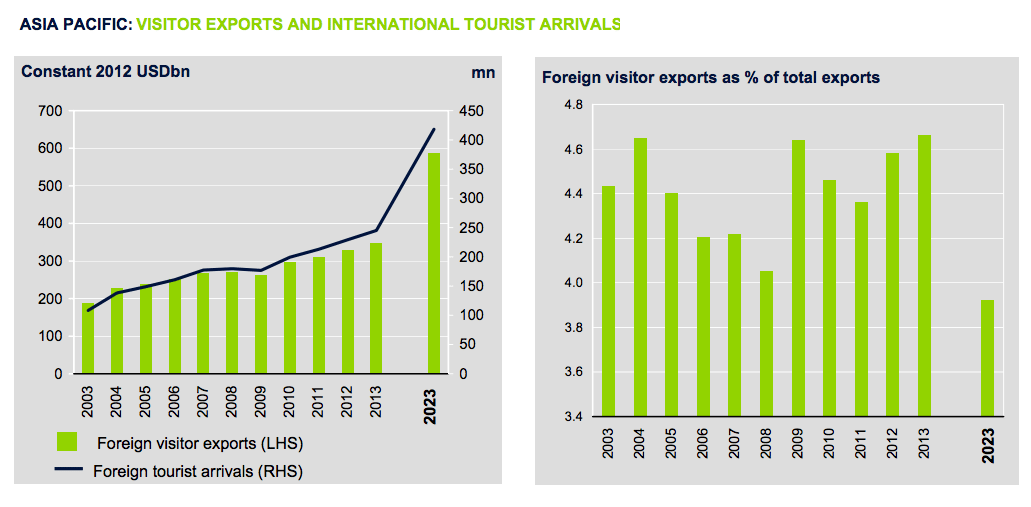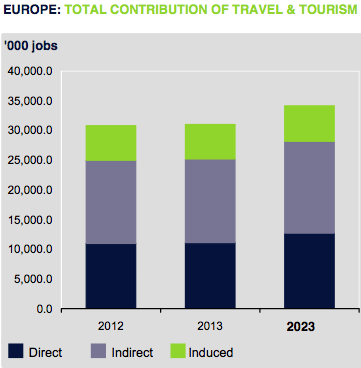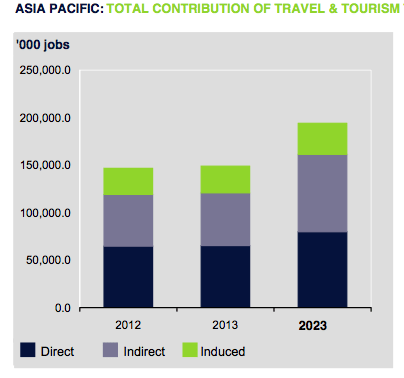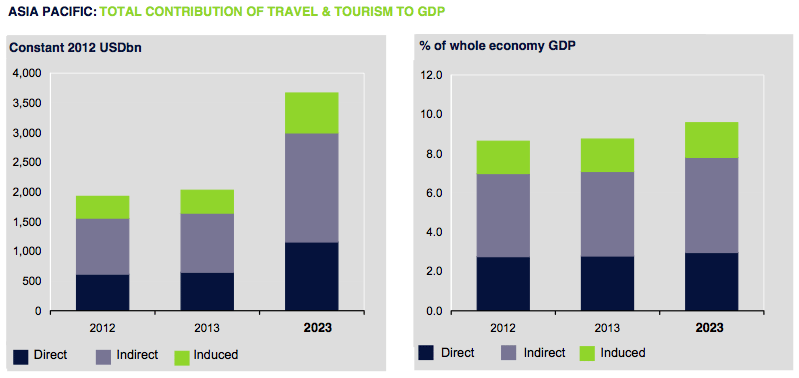Asia is the new king of tourism and everyone else is along for the ride

Skift Take
One billion tourists crossed borders in 2012, a shocking and significant number, but one that means little without looking at the impact it has on our economies and livelihoods.
Last year, travel and tourism created five million new jobs bringing the number of industry-related jobs to a total of 260 million. That means one in every 11 jobs deals with the tourism industry.
The industry was also responsible for $6.6 trillion, or nine percent, of the global GDP in 2012. This contribution is expected to grow 3.2 percent next year.
Despite setback from a global recession, travel and tourism is expected to continue growing in most areas around the world.
For a quick snap shot, we've used data from the World Travel and Tourism Council to compare travel and tourism's contribution to GDP and job creation for 4 major world regions.
Where tourism is making money
The fastest growing tourism economies are going to be found in Asia in the coming years.
China is forecasted to overtake the United States to become the world's biggest tourism economy in 2023 with travel accounting for 10.4 percent of Chinese GDP and 11.1 percent of total employment.
| Region | 2012: % of GDP | 2013: % of GDP | % change | Prediction for 2023 |
|---|---|---|---|---|
| Africa | 9.0% [$173.1bn] | 8.9% [$179.1bn] | 3.4% | 8.8% [$293.6bn] |
| Asia Pacific | 8.6% [$1,925.5bn] | 8.7% [$2,027.8bn] | 5.3% | 9.6% [$3,665.8bn] |
| Americas | 8.6% [$2,001.4bn] | 8.6% [$2,059.7bn] | 2.9% | 9.1% [$2,946.0bn] |
| Europe | 8.2% [$1,736.1bn] | 8.2% [$1,750.4bn] | 0.8% | 8.4% [$2,287.4bn] |
In the coming year, travel and tourism will have a significant impact on the GDPs of most Asian nations. Its GDP contribution is expected to increase 11.5 percent in Cambodia, 9 percent in China, 5.8 percent in the Philippines, and 1.6 percent in Hong Kong.
On the flip side, the tourism economies of Spain, Germany, Italy, Greece, and the UK are only expected to grow between 1.1 and 2.1 percent.
Similarly, tourism's impact on the economy is only expected to increase 2.1 percent in the United States in 2013.
Where tourism is creating jobs
Asia's thriving tourism economy will boost job creation and Europe's will continue to create employment despite its weakness; however, it will be Africa and the Americas that see the greatest job creation in the tourism industry in the coming year.
| Region | 2012: % of jobs | 2013: % of jobs | % change | Prediction for 2023 |
|---|---|---|---|---|
| Africa | 7.1% [19.25M] | 7.1% [19.67M] | 2.2% | 7.0% [24.85M] |
| Asia Pacific | 8.0% [146.67M] | 8.0% [148.9M] | 1.5% | 9.4% [194M] |
| Americas | 9.3% [40M] | 9.4% [40.9M] | 2.2% | 10.3% [51M] |
| Europe | 8% [30M] | 8% [31M] | 0.7% | 8.6% [34.15M] |
Travel and tourism is predicted to create the fewest jobs in Europe over the next year. The number of industry-related employment is expected to drop between 1.1 and 2.1 percent in Spain, Germany, Italy, and Greece. Those numbers could start bouncing back by 2023.

One of the few countries where industry-related jobs are actually expected to rise in 2013 is in the UK where after a 1.1 percent increase, 7.7 percent of total employment with be in travel and tourism.
Although tourism's contribution to Asia's GDP will be growing quickly over the next ten years, it will only be creating jobs in some regional countries in the short term.
The number of jobs in travel and tourism in Hong Kong and South Korea is expected to decrease or stay the same.

On the other hand, employment in the tourism industry is forecasted to increase 9.4 percent in Thailand, 4 percent in Philippines, 3.8 percent in Australia, and just 1 percent in China.
In the United States, travel and tourism is forecasted to contribute 10 percent of all jobs this year, which is just a small 0.6 percent increase over 2012.





